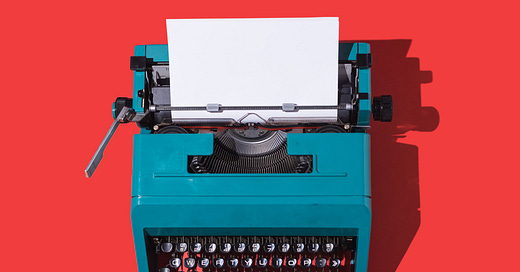Hook The Reader With A Strong Lede
Whether a Substack post, oped or email query your first line is critical
You may have heard: people are overwhelmed with too much information.
Which is why you must get to the point quickly in your writing.
The way to do this is with a strong lede.
lede /lēd/: the opening sentence or paragraph of a news article, summarizing the most important aspects of the story.
I learned this writing newspaper columns in the days when set word counts had to be obeyed. Every word mattered; there was no room for fluff or taking your time to make a point.
Nowhere was this harder than at USA Today, where my print column was an improbable 550-600 words, forcing me to master the skill of economical writing. Imagine trying to convince people to support immigration or health care reform with that word limit.
Infrequently, I'd be granted more space, but it was circumscribed by what was physically available on the page, unlike Internet writing, which has no real limit, at least when you are your own editor/publisher.
Either way, I had one shot to grab the reader's attention, and that was my opening sentence.
The columns I wrote there, and before that at the Daily Beast, were often impactful and frequently went viral. One of my viral columns reached over 1 million page views and was the number one read article, not just a column, at USA Today for nearly a week.
I don't think my writing went viral or had an impact just because of the ledes. But without a clear hook to attract the reader who had so much else competing for their attention, these columns would have reached a fraction of the audience.
The same is true of your Substack post or email query asking a public figure to be interviewed for your newsletter or to speak to your organization. If you have drafted an op-ed, it will have a far greater chance of being published if it has a strong lede.
So, what makes for a great lede?
A strong lede is clear, succinct, and intriguing.
It should make the reader feel curious to know more.
Here is an example from the first line of a post this week from Substack superstar
:This Substack you’re reading now, The Hyphen, accidentally turned into a 6-figure business last year.
Doesn’t this make you want to know more? How do you accidentally make over a hundred thousand dollars?
A viral Substack post I published in November 2023 started this way:
I don't remember exactly when it happened for me, but the thought arose with surprising clarity: something is deeply wrong with the United States, and I don't want to live here anymore.
This gets right to the point and offers a little provocation. It pulls in people who also have thought of leaving the U.S. as well as those who are offended by the idea that there could be anywhere better to live than America.
In a recent workshop on how Substack posts go viral,
explained that one thing viral posts have in common is that they speak to those who agree with them while also garnering the attention of those who oppose them. Sarah actually used my essay as her case study, and that's how I realized (only in hindsight) how much I had packed into that one sentence lede.A lede should be direct, not a slow wind-up.
Unless you are a super-famous writer with a devoted following that hangs on your every word, it’s best to not open with a meandering remembrance of how you came up with the topic for that day's essay. If you are sending an email to make a request on someone’s time, keep superfluous information to a minimum and definitely don’t open with it.
Just get to the point.
Sometimes, I'll see a headline and get excited about the topic.
The next thing I know, I’m reading what feels like a journal entry. I begin scanning to locate the topic promised in the headline, but the effort to find it deters me from sticking with the article or post. (To be clear, I’m not talking about round-up posts or Substacks that are consistently formatted as a chatty newsletter. I’m referring to posts dedicated to an essay on a particular topic.)
Or, I open an email with dense paragraphs of information to wade through before I reach the purpose of the missive. I’ll often feel overwhelmed and move on to the next email, always meaning to get back to the long email but often forgetting.
Ask yourself: can the reader surmise from my opening sentence or sentences what the premise or purpose of my essay/oped/email is?
If not, rewrite it until they can.
Here is
again jumping right in for her viral essay Goodbye, Instagram:Like many people my age, I excitedly joined Instagram in 2010 when it first came onto the scene. The cool younger sister to Facebook, I was a plugged-in hungry Millennial and I loved the “insta” effect — the collective trend to post about your life in real-time.
An example of a slightly longer—but still engaging—lede comes from an article in the Hedgehog Review, Toward a Leisure Ethic:
When nineteenth-century Western colonists and researchers encountered supposedly "primitive" societies like the Samoans in southwest Polynesia, they marveled at how much free time the people seemed to have. "Time is plentiful in the South Seas, and cares are few," wrote the American ethnologist William Churchill. "Life has no engagement so important that the islander will not cancel it at once on the plea of sport."
Do you see what I mean?
In the opening lines, the writer dives into the topic of his essay and piques your interest with interesting facts about how different cultures view leisure. You know exactly where you are headed.
With Emma Gannon’s piece, the headline tells us where she is going with the essay, while the lede tells us from whence she came. We can immediately tell this will be a personal reckoning with social media.
A strong lede is authoritative and unapologetic.
Part of being direct and clear is speaking with authority.
People are reading your work because you are the expert. You have done the research, earned the degree, or lived the life, and now you are writing about it.
Own it.
In the opening of my essay about why I want to leave the United States, I could have watered it down so as to not offend anyone. I could have played small and offered "on the one hand, on the other hand," equivocations.
That would have been a mistake.
There is no way to be an interesting writer, thinker, or anything really and please everyone.
Or if you are sending an email to some bigwig to make a request, don’t apologize for bothering them or try to justify your request. Ask them directly for what you want or need from them. The worst they can do is say no or ignore you.
Women, in particular, can have a hard time stepping into their authority even when they have more credentials, experience, and knowledge than everyone around them.
A male magazine editor told me once that he would call women who were the foremost experts on an issue and ask them to submit an oped, and they would say they didn't feel they knew enough. Then he'd call a man without any particular expertise in the issue and they'd have the oped to him the next day. This is not to say all men know how to own their authority, but it can be more challenging for women.
Lay down a marker in your lede and you will establish yourself as a trusted authority to the reader.
Now, go write a great lede.
The excess of room we have for online writing can make us lazy and cause us to waste space with words that don't matter. The lede isn't the only part of your writing that should be stripped down to its bones—every sentence and paragraph should get this treatment—but it's the best first place to start.
If you want to give it a try, take an old post, essay, or email that didn't get the response you hoped and rewrite the lede. Feel free to post the original and the rewritten lede in the comments, and I'll do my best to give you feedback.










Thank you! Thank you! Thank you! That's for emphasis and deep appreciation. Please write more about writing more.
When I saw “lede” instead of “lead,” I sorta squealed a bit with glee and couldn’t click on that link fast enough! Inkstained newsies are my community... I made a tshirt once that is the framework of every article; hed, dek, lede, graf, graf, graf, kicker. All you ever need for any story ever. If it’s too long to fit, keep honing until you get there. If the reader doesn’t have the 5Ws by the bottom of the first graf, rework that sucker.
I have a friend who writes historical literary essays ... she’s very good, but she always writes her lede in the second paragraph. She doesn’t do it intentionally, but she knows when she asks me to edit something, I’m gonna tell her to whack away the entire first graf, that her lede is her second graf. But she needs to write that first graf to get to her second/lede ... but then *really* doesn’t want to let her words go... (I use the metaphor of a muffin top... you can’t just bake muffin tops without making a whole muffin. It needs the stump, even when you discard it. That’s why making just the tops failed! She hates that metaphor because she knows I’m right... 😀)
Good ledes probably have a lot of discarded muffin stumps along the wayside.